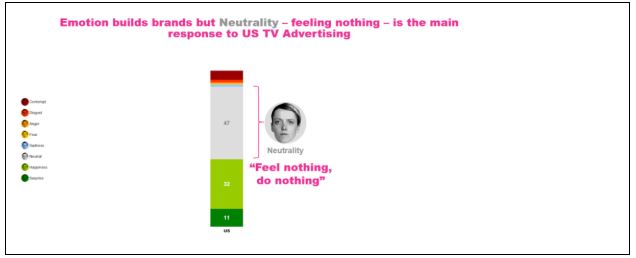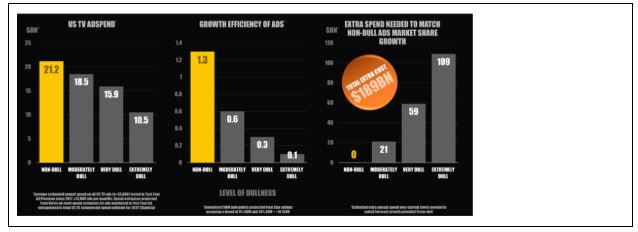The Real Price of Forgettable Advertising: New Insights Into Ad Engagement
At the Cannes Lions International Festival of Creativity, global marketers gathered to celebrate innovation and push the boundaries of what’s possible in digital advertising. With sessions like “Entertain or Die” and “Advertising That Sparks Emotion”, the message was clear: engaging advertising is no longer optional. It’s essential.
But while much of the spotlight was on interactive ads and cutting-edge creative, System1’s Jon Evans (CMO and host of the Uncensored CMO podcast) and Adam Morgan (Founder of eatbigfish) took a bold, contrarian stance. In a sea of hype, they unpacked the often-ignored but urgent truth about underperforming campaigns: when ads fail to capture attention or spark any emotional response, brands pay a steep price in wasted spend and missed opportunities.
In their talk, The Extraordinary Cost of Dull: Why Boring Advertising Must Die, they revealed new data showing just how damaging low user engagement and weak emotional impact can be to brand recall, ad engagement rates, and long-term marketing performance.
Read on for key takeaways – and download the full The Extraordinary Cost of Dull research to discover how to create ad campaigns that cut through the noise, drive interaction, and keep your brand top of mind across platforms.
When Ads Fail to Engage, Brands Pay the Price
At System1, we’ve analyzed over 100,000 commercials to uncover what drives real advertising impact.
One insight stands head and shoulders above the rest: Happiness fuels commercial results.
When people feel good watching an ad, it creates stronger brand associations, improves memorability, and drives better engagement metrics across platforms – from social media to display to interactive video ads.
And while negative emotions like Fear or Anger can also generate attention in the short term, it’s emotional intensity – not just valence – that determines whether an ad will resonate or be ignored. Simply put, the more emotionally engaging an ad is, the more likely it is to drive action and boost ROI.
Meet Neutrality, the Silent Killer
Here’s the catch: most ads don’t stir any emotion at all. They fall flat. Across our database, 52% of UK ads and 47% of US ads are met with complete neutrality – no emotional lift, no response, no engagement. In an age where brands fight for relevance across increasingly crowded marketing channels, that’s a huge missed opportunity.

But this emotional flatline doesn’t just affect brand recall; it affects your budget. Working with Adam Morgan and effectiveness expert Peter Field, we explored the true Cost of Dull: how much more brands need to spend on media to compensate for ads that fail to engage. Spoiler alert: the difference isn’t marginal.
The question we set out to answer: What does it really cost when your ads don’t move people? When they aren’t effective? And how can brands escape the engagement dead zone — even in low-interest categories?
The Hidden Cost of Emotionless Ads
Neutral ads don’t actively damage a brand, but they don’t do much to help either. Yes, they can raise Brand Fluency and boost mental availability. They may even drive short-term sales. But here’s the catch: they’re far less efficient than emotionally engaging campaigns.
A neutral ad might still work, but it’ll cost you more to achieve the same results. That’s the real problem – not harm, but waste. When an ad fails to evoke emotion, you’re paying more for less impact. Media budgets are stretched thinner, and ROI takes a hit.
How Dull Becomes Expensive
To put numbers to this problem, we took a fresh look at our Test Your Ad database – this time analyzing ads based on how Neutral the audience response was. We grouped the data into four quartiles to illustrate how increasing neutrality affects efficiency and emotional engagement:
- Non-Dull – These ads still receive a fair share of neutral responses from consumers (39% in the UK, 32% in the US), but they also spark higher levels of positive emotions like Happiness and Surprise.
- Moderately Dull – With Neutrality creeping up (49% UK, 44% US), positive emotional response begins to decline.
- Very Dull – Now, Neutrality is the dominant reaction (56% UK, 51% US), with Happiness and Surprise falling sharply.
- Extremely Dull – Emotional flatline. Neutrality hits 65% in the UK and 62% in the US. Positive feelings are rare, and impact is minimal.
One surprising finding? As Neutrality increases, positive emotions fade – but negative ones don’t. Whether an ad is engaging or dull, a baseline level of negative emotion (like Anger or Contempt) remains.
So trying to “play it safe” by removing edge or energy from your ad doesn’t protect your brand. It just hinders positive reactions, and leaves you with an expensive neutral.
OK, So How Much Does Dull Advertising Cost?
Engaging ads don’t just make people feel something – they actually work harder. They’re more memorable, more effective, and much more efficient. If your ad sparks interest and emotion, your media spend goes further. But with a dull ad? You’re simply paying more for less.
To put real numbers behind this waste, we worked with Nielsen TV spend data to see how much budget was being spent across different levels of ad neutrality. Then we compared those spend levels with the predicted performance of each ad based on its Star Rating: our metric for long-term profit gain and market share growth.
For consistency, we assumed a level playing field: every brand starts with 5% market share and invests to achieve +10% ESOV (Excess Share of Voice), which is the benchmark we use for reliable performance forecasting.
Then we asked the big question:
How much extra money does a brand need to spend to make a dull ad perform like a non-dull one?
Spend Follows Emotion (To a Point)
The good news: marketers often know when they’re sitting on a strong ad, and tend to invest accordingly. Non-dull ads – those with the lowest neutrality – attract more spend than dull ones. But even the most boring ads still rack up major investment.

- UK: Out of an estimated £5.11bn total TV ad spend, the non-dull quartile accounts for £1.61bn (31.5%).
- US: From a $66.1bn total, non-dull ads get $21.2bn (32%).
At the other end, extremely dull ads – those with the highest neutrality – still attract £0.95bn in the UK and a staggering $10.5bn in the US. That’s a lot of budget going toward ads that aren’t engaging viewers.
The Efficiency Gap Gets Expensive – Fast
Using Test Your Ad report metrics, we predict that a brand with a +10 ESOV and airing non-dull ads would see an annual market share gain of 1.3 points in the US (1.26 in the UK). That’s strong, efficient growth.
Now compare that to extremely dull ads, with the exact same spend:
- US: Only 0.1 points of share gain – 13x less efficient.
- UK: Just 0.13 points of share gain.
To match the performance of a non-dull ad, you’d need to overspend dramatically:
- $109bn more in the US
- £7.94bn more in the UK
That’s more than the entire annual US TV ad spend – just to make dull work as hard as interesting creative.
And that’s just for the most neutral ads. If we include moderately dull and very dull ads in the equation, the total extra spend needed climbs to:
- $189bn in the US
- £13.29bn in the UK
There’s a Smarter Way to Spend
Instead of pouring billions into media to compensate for creative that doesn’t land, there’s a much simpler and cheaper fix: make interesting ads.
The full Cost of Dull whitepaper shows you how, with:
- The “Four Horsemen of the Dullocalypse” – the major creative traps behind emotional flatlines
- Diagnostic questions to help you avoid dull when developing ads
- Creative features identified by System1’s Orlando Wood that drive engagement that supports long-term brand building
- Examples of brands making emotional ads in “boring” categories
- And a special look at the cost of dull for B2C vs B2B advertising
Because when it comes to commercial creativity, playing it safe is the riskiest move you can make.
Ready to learn more? Download the full Cost of Dull whitepaper for free today →
